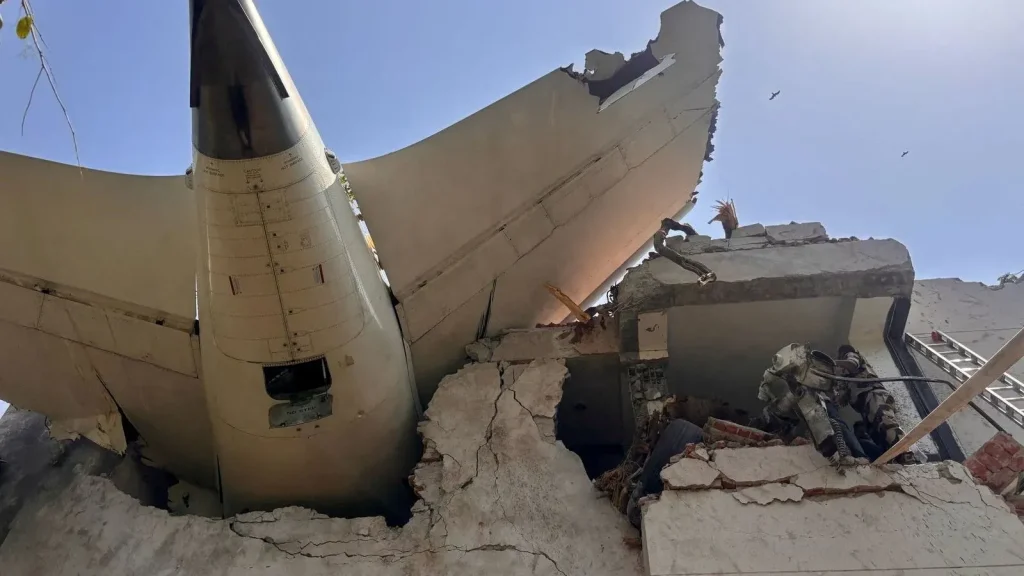The tragic crash of Air India Flight 171 on June 12 has drawn significant attention from both the public and aviation authorities, following the devastating loss of 270 lives, including passengers and people on the ground. Preliminary reports from the Aircraft Accident Investigation Bureau suggest that a fuel switch failure may have played a critical role in this Boeing 787 Dreamliner accident, raising alarms about aviation safety protocols. Investigation findings indicate that the fuel cutoff switches were erroneously turned off shortly after takeoff, which complicated engine recovery efforts and ultimately led to the crash. Detailed Air India crash details continue to emerge, as the airline collaborates closely with regulators to understand the factors that contributed to this catastrophic event. As the world watches, this incident highlights the pivotal need for rigorous aviation safety investigation to prevent future tragedies.
On June 12, an aviation disaster unfolded when Air India Flight 171 met a tragic fate, resulting in a substantial loss of life. Preliminary insights into the incident reveal that a malfunction associated with fuel switch operations may have caused critical failures in the aircraft’s engine systems. As investigators delve deeper into the circumstances surrounding this Boeing 787 accident, the focus is squarely on understanding what went wrong during the flight’s takeoff phase. The repercussions of this catastrophic event extend beyond just the aircraft, affecting families, communities, and the overall trust in aviation safety. With the involvement of international investigative bodies, a thorough examination of all facets will be undertaken to ensure accountability and prevent similar occurrences in the future.
Air India Flight 171 Crash Overview
On June 12, Air India Flight 171 tragically crashed just 171 seconds after takeoff, marking a devastating incident in aviation history. This catastrophic accident, which involved a Boeing 787 Dreamliner, led to the loss of 270 lives — 241 passengers and 29 individuals on the ground. The crash occurred shortly after the plane departed from Ahmedabad, bound for London. Aviation safety investigations are underway to understand the circumstances that led to this tragic event, with preliminary reports indicating that fuel switches had been turned off, a critical safety oversight.
The investigation into the Air India Flight 171 crash, which resulted in the deaths of nearly all those onboard, is being conducted by the Aircraft Accident Investigation Bureau (AAIB). This body, along with support from international agencies, aims to piece together the factors contributing to this disaster. As the world reflects on this tragedy, insights from the preliminary reports highlight crucial aspects of aviation safety and the stringent requirements for pilot training and emergency protocols.
Details from the Preliminary Investigation Report
The preliminary investigation report released by the Aircraft Accident Investigation Bureau revealed shocking details regarding the Air India crash. Notably, the fuel cutoff switches for both engines were shifted from ‘run’ to ‘cutoff’, a situation that would have immediate and severe implications on the aircraft’s ability to maintain flight. The cockpit voice recordings captured vital exchanges between the pilots, one of whom questioned why the switches were turned off, leading investigators to focus on procedural adherence and human error as potential contributing factors in this critical incident.
In analyzing the aircraft’s systems, the report outlined attempts to recover engine functionality after the switches were inadvertently turned off. Engine 1 showed some signs of recovery, while Engine 2 struggled to regain proper function, eventually leading to its failure. This highlights the intricate engineering of the Boeing 787 Dreamliner and raises important questions regarding system redundancies and pilot training.
Implications for Aviation Safety
The crash of Air India Flight 171 underscores significant implications for aviation safety protocols worldwide. Preliminary findings have triggered a renewed emphasis on ensuring that cockpit procedures are strictly adhered to, especially regarding critical systems like fuel management. Any lapses in these protocols can have dire consequences, as evidenced by this tragic event. The investigation is aimed at identifying not only the immediate causes but also systemic issues that could be addressed to prevent future occurrences.
Furthermore, this incident raises questions about the effectiveness of existing aviation safety regulations and the need for comprehensive training for airline crews. As aviation authorities review the findings, it is vital that lessons are learned, and necessary changes implemented to bolster safety measures across the industry. The joint investigation effort between domestic and international agencies exemplifies the globalization of aviation safety and highlights the importance of collaboration in response to such catastrophic events.
Insights on the Boeing 787 Dreamliner Accident
The Air India Flight 171 crash marks a significant moment for Boeing’s Dreamliner series, which has largely been praised for its innovative design and technology since it entered commercial service in 2011. However, this incident reveals potential vulnerabilities within this aircraft model. As investigations progress, experts will meticulously analyze the aircraft’s safety systems, including its fuel management protocols and failure contingencies, to draw lessons that can enhance the overall safety and reliability of the Boeing 787.
Boeing’s immediate response to this incident has been one of solidarity, extending thoughts and support to the families affected by the crash. The company’s cooperation with investigative bodies underscores its commitment to addressing safety concerns and implementing any necessary repairs or updates to the Dreamliner fleet. It is crucial for Boeing to not only rectify the issues highlighted by this tragedy but also to restore public confidence in its products moving forward.
Human Error and Training Protocols
Central to the investigation of the Air India Flight 171 crash is the question of human error and the adequacy of pilot training protocols. Preliminary reports suggest that the fuel switches were improperly managed, raising concerns about whether pilots were sufficiently trained to handle emergency situations. Investigators will delve into the specifics of training regimens for Air India’s flight crews, particularly focusing on their ability to adhere to procedures during critical phases of flight.
In addition, this incident brings forth discussions about enhancing simulator training for pilots to better prepare them for potential malfunctions and unexpected scenarios like fuel management failures. Strengthening these protocols could significantly improve response times and decision-making during emergencies, thereby reducing the likelihood of similar accidents in the future. As the investigation unfolds, the revelation of any lapses in training or compliance could lead to industry-wide reforms.
Community Support for Victims’ Families
The tragic loss of life in the Air India Flight 171 crash has deeply affected communities both in India and abroad. Air India expressed its condolences and commitment to provide support to the families left mourning the loss of their loved ones. The airline’s commitment to assisting victims’ families during this harrowing time reflects an essential component of crisis management in the aftermath of an aviation disaster.
In addition to corporate support, community outreach initiatives may also play a pivotal role in aiding those affected by the tragedy. Local organizations and support groups are likely to mobilize efforts to provide psychological care and assistance to grieving families, emphasizing the collective responsibility to aid in their healing process. The impact of such accidents is felt globally, highlighting the interconnectedness of communities and the shared grief of lost lives.
Regulatory Responses and Oversight
In light of the Air India Flight 171 disaster, regulatory bodies such as the Directorate General of Civil Aviation (DGCA) in India are under pressure to reassess and reinforce aviation safety standards. Immediate recommendations have included enhanced maintenance protocols and rigorous checks for the Boeing 787 fleet. This reflects a broader recognition of the need for stringent oversight in all aspects of aviation safety management.
As the investigation progresses and final reports emerge, regulatory agencies will likely incorporate findings to advocate for fresh legislation or enhanced compliance measures geared towards preventing similar accidents in the future. This incident serves as a reminder of the importance of continuous improvement in aviation safety standards, particularly in a rapidly evolving industry where technology and operational strategies must adapt to emergent challenges.
The Role of Black Box Analysis in Investigations
The analysis of black box data is a critical component of aviation accident investigations, including that of Air India Flight 171. The cockpit voice recorder and flight data recorder provide invaluable insights into the events leading up to a crash. In this case, the recorded cockpit exchanges have already played an instrumental role in piecing together the timeline and decision-making processes of the flight crew.
Investigators utilize black box data not just to examine technical failures, but also to understand human factors that may have contributed to the crash. The findings from these analyses often lead to significant recommendations for operational changes and safety training improvements across the aviation industry. This episode emphasizes the need for thorough scrutiny and the integration of technology in enhancing aviation safety.
Future of Boeing Dreamliner Safety Regulations
As the investigation into the Air India Flight 171 crash continues, the future of safety regulations regarding the Boeing Dreamliner will be closely scrutinized. The findings are expected to prompt comprehensive reviews of not just operational practices within the airline but also at the manufacturing level. Future safety regulations could involve enhanced scrutiny on safety features and pilot compliance with critical operational protocols.
The global aviation community will be watching closely, as new safety measures and practices are likely to emerge from the investigation’s outcomes. The input from various regulatory agencies and industry stakeholders will be vital in ensuring that such fatal incidents do not recur, protecting passengers and preserving the industry’s integrity.
Frequently Asked Questions
What are the Air India crash details for Flight 171?
Air India Flight 171 crashed on June 12, shortly after takeoff from Ahmedabad, killing 270 people, including 241 passengers and crew onboard, and 29 individuals on the ground. A preliminary report from the Aircraft Accident Investigation Bureau revealed that the fuel switches for the engines were turned off prior to the crash.
What caused the Boeing 787 Dreamliner accident involving Air India Flight 171?
According to the preliminary report, the Boeing 787 Dreamliner operated by Air India experienced a crash due to the fuel cutoff switches being mistakenly turned to ‘cutoff’ for both engines just 171 seconds after takeoff, leading to engine failure and subsequent crash.
How is the aviation safety investigation being conducted for the Air India Flight 171 crash?
The aviation safety investigation for the Air India Flight 171 crash is being conducted by India’s Aircraft Accident Investigation Bureau, which is collaborating with the U.S. National Transportation Safety Board due to the involvement of a U.S.-manufactured aircraft, the Boeing 787.
What findings does the Aircraft Accident Investigation Bureau have regarding the Air India crash?
The Aircraft Accident Investigation Bureau’s findings indicated that the fuel switches were turned from ‘run’ to ‘cutoff,’ leading to a rapid deceleration of the engines. Despite attempts to relight the engines, the aircraft could not regain sufficient power before it crashed.
What actions has Air India taken following the Flight 171 crash?
Following the Air India Flight 171 crash, the airline has committed to work closely with regulators and the Aircraft Accident Investigation Bureau. As a precautionary measure, the Directorate General of Civil Aviation has mandated extra maintenance checks on Air India’s Boeing 787-8/9 aircraft.
What was the passenger capacity and fate during the Air India Flight 171 accident?
Air India Flight 171 was carrying 230 passengers and 12 crew members when it crashed. Only one survivor, Ramesh Viswashkumar, was found among the 241 individuals on board, while an additional 29 people on the ground were also killed in the incident.
What immediate steps were taken after the Air India Flight 171 crash?
Immediately following the Air India Flight 171 crash, the Directorate General of Civil Aviation requested Air India to enhance maintenance protocols for its fleet of Boeing 787s, while the investigation into the crash began with an analysis of the black boxes retrieved from the crash site.
What was the response from Boeing regarding the Air India Flight 171 investigation?
Boeing expressed its support for the investigation into the Air India Flight 171 crash and offered condolences to the families of the victims, recognizing the tragedy and emphasizing the importance of a thorough investigation.
Why is the Air India Flight 171 crash significant in aviation history?
The Air India Flight 171 crash is significant as it marks the first incident involving Boeing’s Dreamliner series, which entered commercial service in 2011, raising concerns about the aircraft’s safety amidst ongoing investigations into potential maintenance and operational flaws.
How is Air India supporting families affected by the Flight 171 crash?
Air India is providing support for the families affected by the Flight 171 crash, expressing solidarity with them during this challenging time and assuring them of continuous assistance as the investigation proceeds.
| Key Point | Details |
|---|---|
| Incident Date | June 12, shortly after takeoff |
| Flight Details | Air India Flight 171, Boeing 787-8, carrying 230 passengers and 12 crew members |
| Fatalities | All but one of the 242 people onboard died with 29 others on the ground |
| Cause of Crash | Fuel switches turned off, leading to engine failure shortly after takeoff |
| Initial Response | One pilot issued a mayday call before losing altitude and crashing |
| Investigation Status | Preliminary report released; ongoing investigation by the Aircraft Accident Investigation Bureau |
| Boeing and Air India Response | Boeing supports the investigation; Air India vows support for affected families |
Summary
The Air India Flight 171 crash, which occurred shortly after takeoff on June 12, is a devastating incident that led to the loss of 270 lives. Preliminary reports indicate that the aircraft’s fuel switches were turned off, leading to catastrophic engine failure. With the ongoing investigation by India’s Aircraft Accident Investigation Bureau, crucial insights are being gathered to understand the full circumstances surrounding this tragedy. The incident highlights the importance of thorough accident investigations and maintenance protocols in aviation safety.



